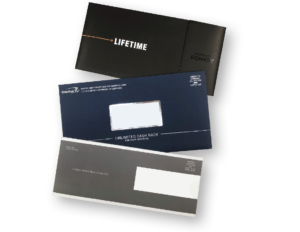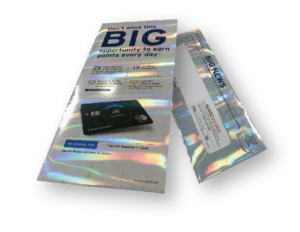Y
our outer envelope’s or sealed self-mailer’s appearance can be the key to whether your mailpiece gets opened or not—but choosing which creative strategy to lead with isn’t always an easy task. We’ve identified seven creative strategies to inspire you and help design the approach that will work best for you, your audience, and your budget.
Print that Wraps
We’re beginning with the easiest idea: designing to add color and imagery to the outside of the envelope. The recipient is presented with something that intrigues them and suggests, visually, that this envelope MUST be opened. We’ve seen this done with great success in several different ways. In its simplest form, a full-bleed image of a surface, such as a brown paper bag, wood grain, or crinkled paper, can be added and carried all the way from front to back on the direct mail piece. Using full-bleed, large photography can also be a showstopper. Also consider using geometric patterns, an illustration, or large typography on a field of solid color.
Designers often focus solely on the front of the envelope, forgetting the back is also valuable design real estate. One of our favorite approaches is to keep the front simple and place a large image on the back of the envelope with a message.
Technology Integration
We love this strategy! Many marketers think of direct mail messaging as low-tech and static. However, today we can combine technology with mail in very exciting ways to garner the recipient’s attention and drive them to take action and open the envelope.
One of our favorite examples comes from an insurance company that combined a physical address with the street image from Google Maps. The street image of the recipient’s house was printed on the envelope using variable data technology, and the company chose a handwritten font for the address. We encourage designers to incorporate handwritten fonts, doodles, and graphics on the exterior design of their envelopes to personalize and draw attention to messaging.
Anytime you can use available data to personalize the message or images on the front or back of your direct mail piece, you exponentially increase the odds that the recipient will open and read the direct mail.
One important note about technology and mail: USPS offers promotions for marketers who integrate technology with their direct mail, and you can qualify for a discount on postage for meeting the requirements of these different programs. Ask Bolger how you can qualify for reduced postage rates by integrating technology into any of your upcoming campaigns, or visit our website for details on current USPS promotions. bolger.com/2022-USPS-Promotions
Leveraging Paper & Scale
Have you ever received a piece of mail in a jet-black envelope? We bet you opened it before any other mail. How about a rich navy blue linen textured envelope with silver foil trim? Maybe a solid gunmetal gray or a shimmery white, pearlized envelope? When we first see a mailpiece with an unusual color in our bundle of mail, most of us would say it seemed important and gave us a sense of feeling significant. Sometimes a quiet, understated, elegant mailer using high-quality paper wins the day.
In this category, size can also be important. It can be a challenge to make the recipient feel truly special with an average-sized envelope. An envelope that is oversized, made of a heavier stock, or made from a stock that boasts a rich, elegant color (such as navy, black, red, or gray) says, “You’re worth it to us.” Loyalty programs, high-end product offers, college acceptance packages, and event invitations are great uses for this strategy.
Special Effects, Textures, & Shapes
Ah, sensory marketing. Where to begin? Whether it’s an envelope, a self-mailer, or a postcard you’re designing for a campaign, you can always add textured coatings that feel like rose petals (soft touch) or sandpaper (grit) or feature high-gloss shine, raised textures, foil, embossing or debossing, etc. The creative opportunities for both long- and short-run campaigns are endless, and many of these special print effects will not add much to the per-piece cost of the run. Ask us about available sensory print offerings.
What about an envelope with an unusual shape? It’s not something you see very often because we’ve all been trained to think of envelopes as rectangular—and to be honest, not many designers or marketers consider this option. However, there’s an envelope style that allows a nonrectangular trail edge die-cut (USPS calls it a TED-C), which is a letter-sized envelope with a die-cut that extends past the conventional trailing edge of the mailpiece. You can do lots of fun things with shapes! For example, Omaha Steaks made the trail edge of their envelope in the shape of a steak. For the bonus win, the TED-C envelope format also qualifies for automation letter prices!
Zip it! Tip it! Peel It!
What’s more fun: tearing the flap of an envelope with your thumb or “unzipping” it? We already know the answer to that question.
By adding a clever opening mechanism, you’ve added a mechanical interaction—not to mention a bit of fun—to opening the mail. A zip strip (or paper zipper) can be added to an outer envelope or self-mailer for instant intrigue and interaction. Did we mention it also delivers a degree of instant gratification? If you’re considering a zip strip, we can’t emphasize enough the importance of partnering with Bolger in advance to help with the placement, as there can be production details that need to be considered at the design stages to ensure the envelope complies with USPS regulations and production processes.
You can also use interesting peel-and-reveal promotions or sticky notes on the outside of the envelope or direct mail piece. USPS refers to these as repositionable notes, or RPN. Typically, the process for this is to print the repositionable note and apply it by machine with standard labeling equipment. Common practice is to print a message that looks like it’s a handwritten personal message, with more detail revealed under the “lift” note. And again, don’t miss the opportunity to use personalization. The goal is to make the recipient become curious about the mailer in their hand and begin interacting with it.
Creativity with Windows
Everyone is used to the classic window envelope, but did you know that you can design custom die-cut windows on your envelopes? Your marketing team and graphic designers can collaborate to make sure the envelope insert is designed to reveal curious bits of imagery through the special die-cut windows.
Windows can also be on the back of the envelope, like in this sample that features an oversized window on the address (flap) side, leaving the entire back (which now appears to be the front) for an unobstructed promotional message and graphics. Notice the use of iridescent paper as well as the change of the copy orientation on the non-address side to be vertical. You can begin to see how these strategies can layer together. Creative window + cool paper + color printing on the exterior = winner!
Crystal clear envelopes are also difficult to resist. Poly envelopes can be four-color printable for a dramatic presentation in the mailbox. They’re auto-insertion compatible and available in standard and custom sizes. As you might expect, crystal clear envelopes are considered nonmachinable on USPS sorting equipment, so you will get hit with the nonmachinable surcharge, but flats in clear envelopes can achieve the USPS automation discounts. For the right customer, they can be worth the extra cost for the created impact.
The “Un-velope”
It’s no secret that due to supply chain issues, companies have faced real challenges with paper and envelope shortages. So, if you can’t get exactly what you want, we challenge you to be creative and try a self-mailing format.
There are many ways to make self-mailers look exactly like envelope mailers, with the easiest of these being simply adding a flap. A flap is created when an extended portion of the address side panel is folded over to the non-address side for the mailpiece closure. The edges must be sealed with tabs or glued to USPS specifications for mailability and machinability, and there are requirements for length and height based on whether they’re off the top or side, so pay close attention to these details.
There are also envelope-like self-mailing formats with integrated pockets, coupons, extra pages, and more. Bolger can help you find the right “un-velope” design, and they have full access to the dieline files of Foldfactory to show you dozens of options.
Try Something New
Direct mail design has endless possibilities, and fresh creative makes people continue to notice and engage with your brand. It’s important to test which creative strategies best fit as solutions for your specific direct mail needs so that when your direct mail arrives in the right hands at the right time, the recipient slows down to look and experience your brand—and then takes that next important step to open, read, and consider your offer.















